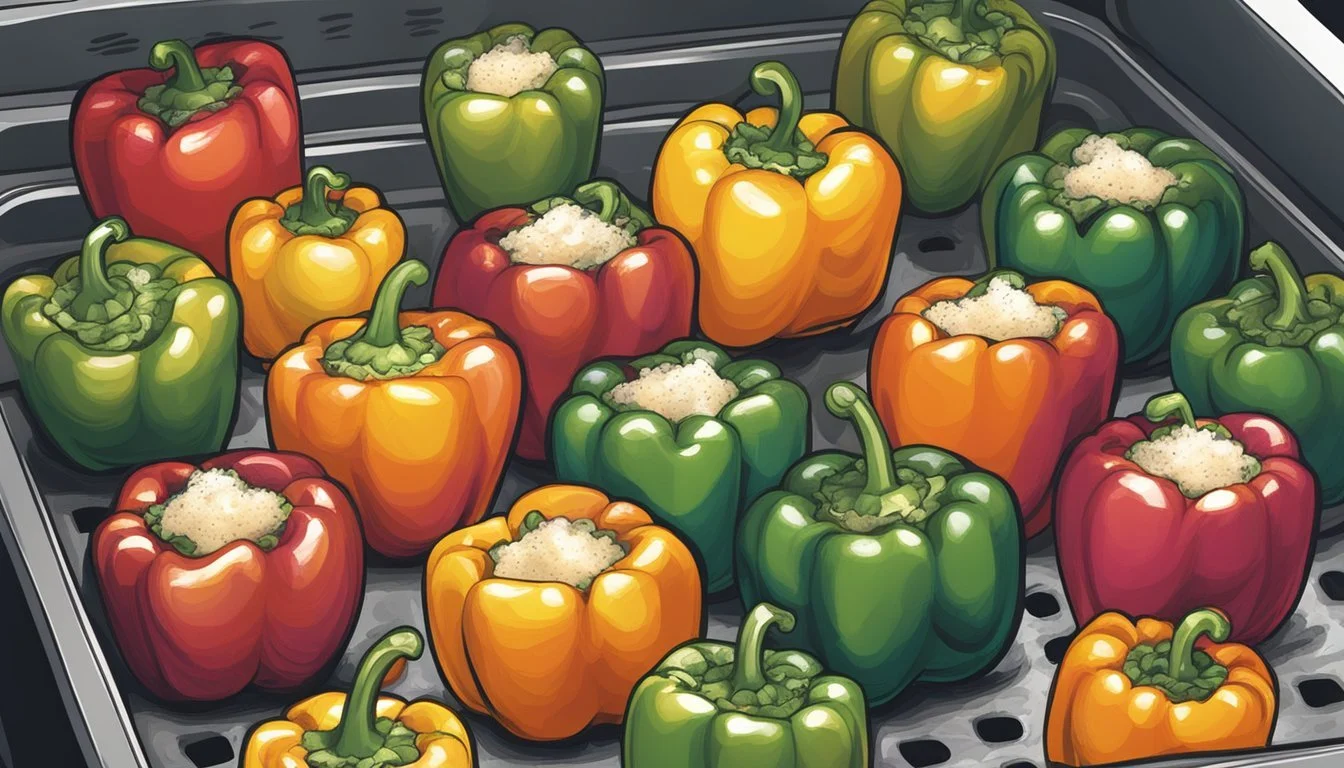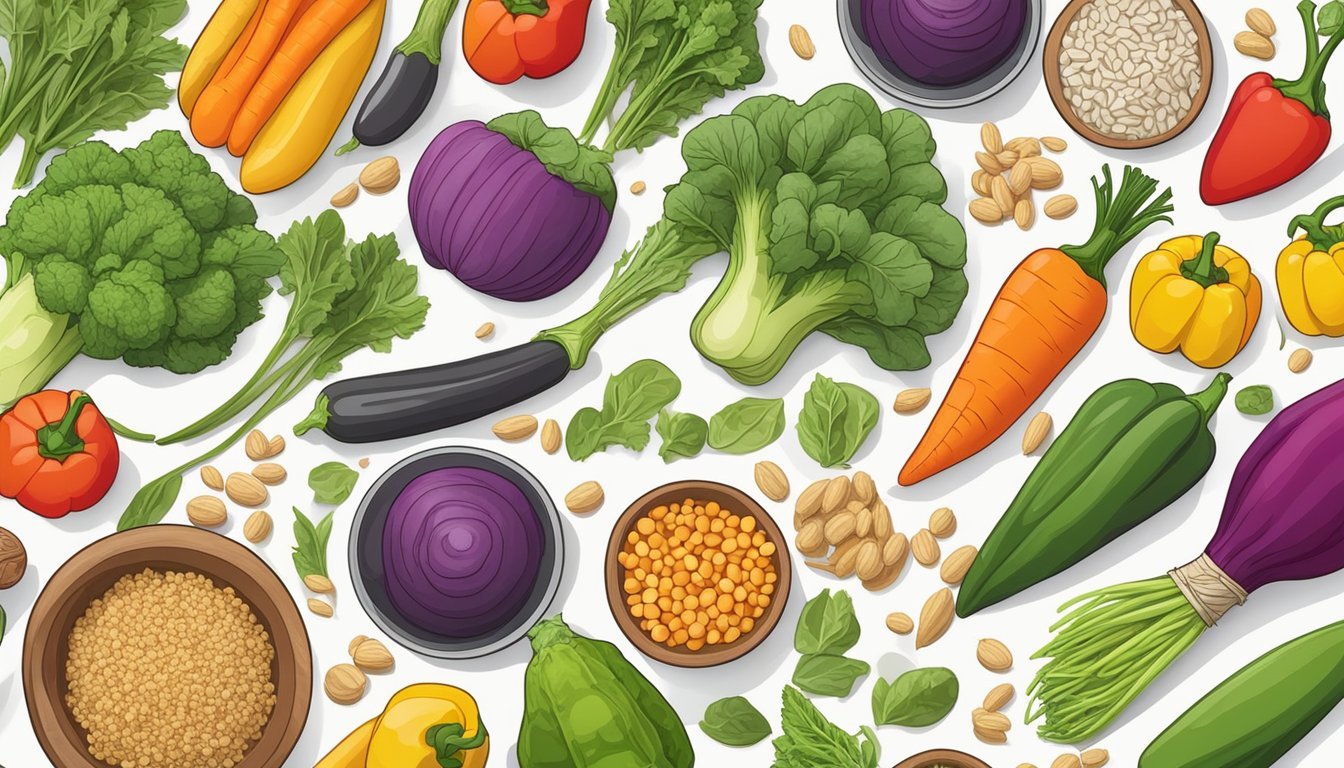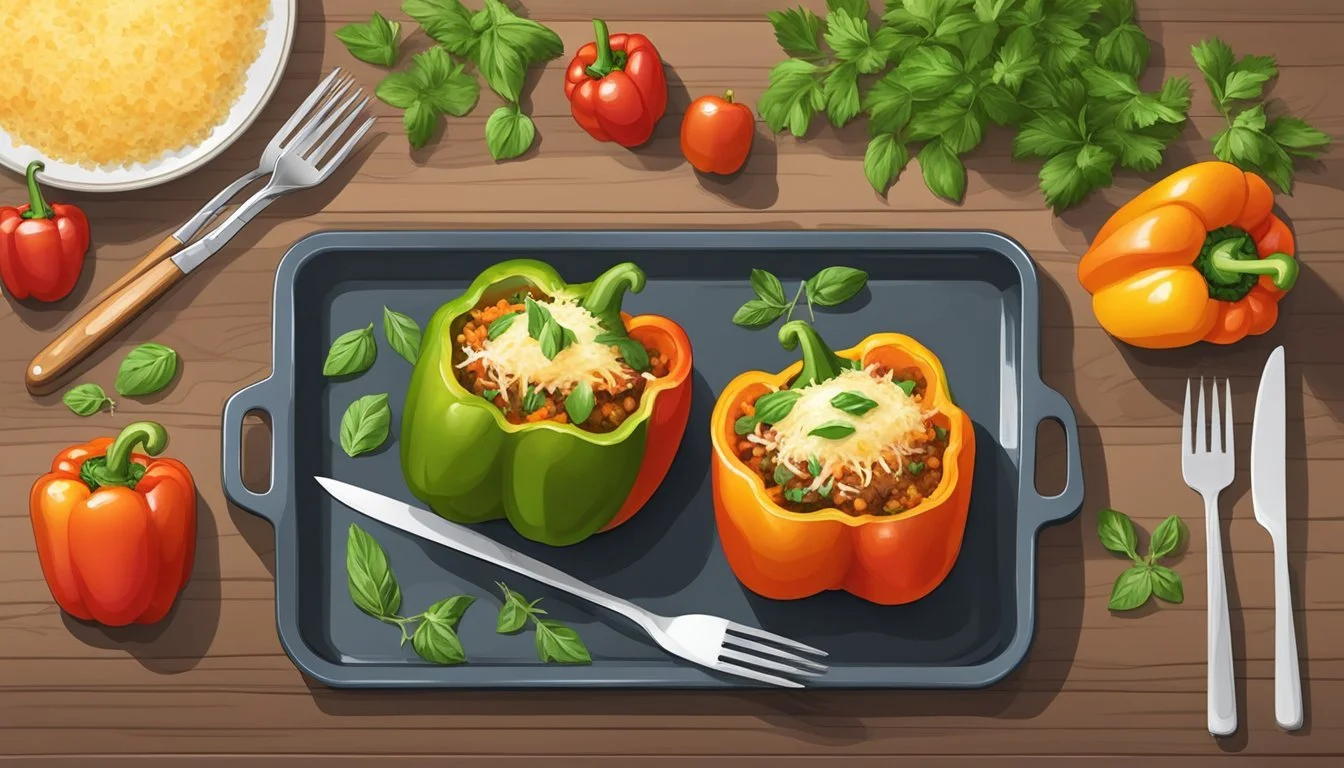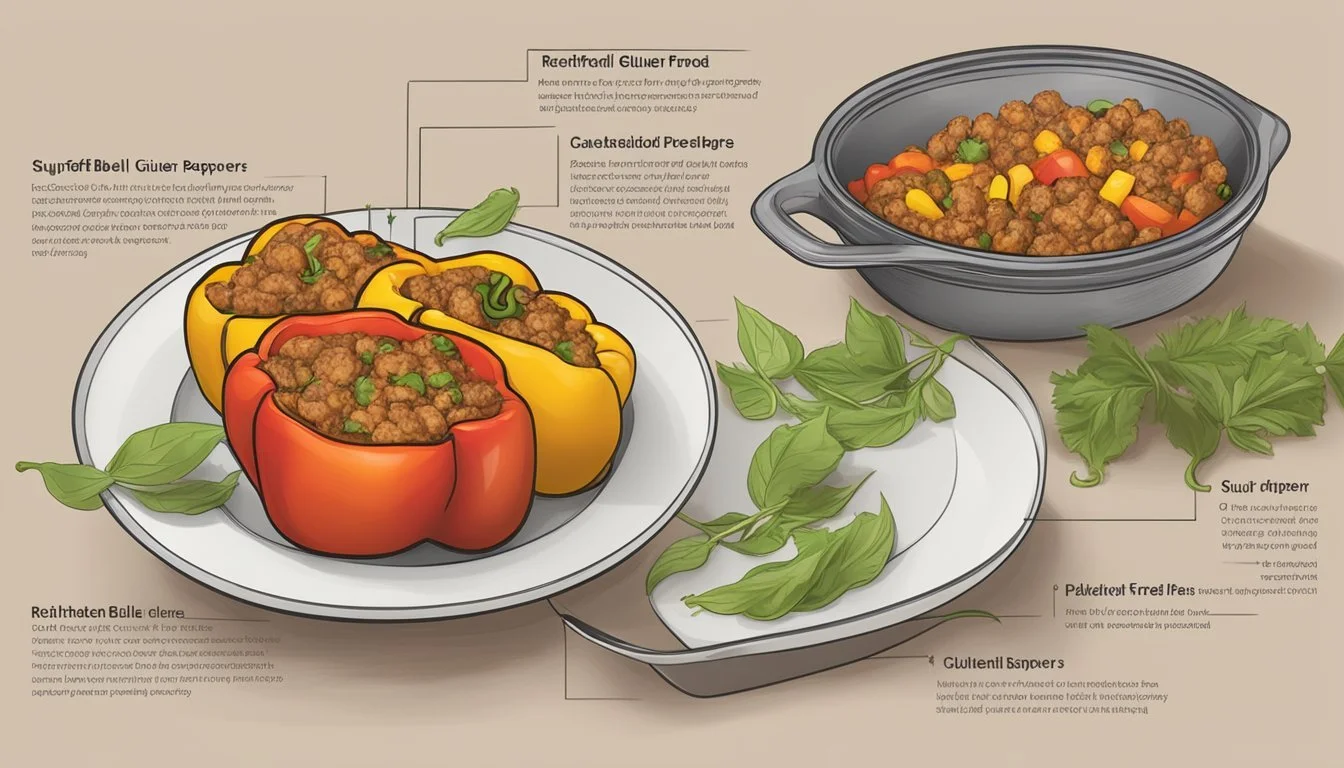How to Reheat Gluten-Free Stuffed Bell Peppers
Best Methods and Tips
Reheating gluten-free stuffed bell peppers might seem challenging, but it can be straightforward with the right methods. The best way to reheat them is by using an oven, which ensures even heating and prevents drying out. Preheat your oven to 350°F (175°C), place the peppers on a baking sheet, and cover them with aluminum foil to maintain moisture.
For those pressed for time, microwaving is a faster option while still achieving good results. Simply place your stuffed bell peppers in a microwave-safe dish, cover with a damp paper towel, and heat in short, controlled bursts until warmed through. Ensure not to overheat to avoid making the peppers soggy.
Alternatively, using a stovetop can also be effective, particularly if you prefer a more controlled method. Simply place the peppers in a covered pan and warm them over low-to-medium heat, adding a splash of water or broth to keep them moist. This gentle reheating method helps maintain the peppers' texture and flavor.
Understanding Gluten-Free Cuisine
Gluten-free cuisine caters to the needs of individuals with dietary restrictions such as celiac disease. It focuses on nutrition and balance while eliminating gluten-containing ingredients like wheat, barley, and rye.
The Basics of a Gluten-Free Diet
A gluten-free diet avoids any foods containing gluten, a protein found in wheats like barley, rye, and oats. This diet is essential for individuals with celiac disease, as consuming gluten can damage their small intestine lining.
People without celiac disease but with gluten sensitivity may also benefit from this dietary approach. Staples in a gluten-free diet include naturally gluten-free foods like fruits, vegetables, meat, fish, eggs, rice, and potatoes.
Fresh fruits and vegetables
Meat and poultry
Fish and seafood
Dairy products
Beans, legumes, and nuts
Health Benefits of Gluten-Free Meals
Gluten-free meals offer numerous health benefits beyond accommodating dietary restrictions. For individuals with celiac disease, these meals prevent severe intestinal damage and associated complications.
Additionally, gluten-free foods often include more nutrients, especially when whole foods like fruits, vegetables, and nuts are prioritized. These foods are rich in fiber, vitamins, and minerals. A well-balanced gluten-free diet can contribute to improved digestion, increased energy levels, and better nutrient absorption.
Overall, focusing on natural and minimally processed foods ensures that those maintaining a gluten-free diet get essential nutrients without compromising their health. This harmonious approach to eating can be both satisfying and healthful.
Selecting Ingredients for Gluten-Free Stuffed Bell Peppers
Selecting the right ingredients for gluten-free stuffed bell peppers ensures a delicious and safe meal. Focus on fresh bell peppers, gluten-free grains and proteins, and flavor-enhancing herbs and seasonings.
Choosing the Right Bell Peppers and Vegetables
Choosing fresh, colorful bell peppers is crucial. Look for firm peppers without blemishes and choose various colors like red, yellow, and green for a vibrant dish. Opt for peppers that can stand upright for easy stuffing.
Other vegetables to consider include tomatoes, onions, and mushrooms. These add flavor and texture. Olive oil can be used to sauté vegetables, enhancing their natural sweetness and adding a slight crisp to the dish.
Picking Gluten-Free Fillings and Proteins
When picking fillings, rice and quinoa are excellent gluten-free options. These grains are versatile, absorb flavors well, and can be cooked in advance. Combine them with vegetables and proteins for a hearty filling.
For proteins, options like ground beef, chicken, and turkey work well. Make sure the meat is finely ground and cooked thoroughly. Ground turkey is a lean option, while ground beef adds richness. Vegetarian options include dairy-free cheese alternatives and legumes like black beans or lentils.
Herbs and Seasonings to Enhance Flavor
Herbs and seasonings make a significant difference. Parsley, cilantro, and basil are great fresh options to add brightness. Dried herbs like oregano and thyme work well in the filling.
Seasonings are essential. Utilize salt, pepper, garlic powder, and paprika. For a bit of heat, consider adding chili flakes or cayenne pepper. A touch of olive oil can bring it all together, ensuring the stuffing is moist and flavorful.
Sticking to gluten-free seasonings will keep the dish suitable for those with gluten sensitivities or celiac disease.
Preparation Before Reheating
To ensure your gluten-free stuffed bell peppers remain delicious, proper storage and understanding prep and cook times are essential.
Storing Leftover Stuffed Bell Peppers
Storage is crucial to maintain the quality of your gluten-free stuffed bell peppers. Once cooked, allow them to cool down completely before placing them in an airtight container to avoid any moisture build-up that can lead to sogginess. Ensure you store them in the refrigerator if you plan to reheat them within the next few days.
For freezing, wrap each pepper individually in aluminum foil and then place them in a freezer-safe bag. This method helps in retaining their flavor and texture. When you're ready to reheat, let the peppers thaw in the fridge overnight for best results.
Prep Time and Cook Time Considerations
Understanding prep time and cook time can make the reheating process smoother. Allow the stuffed peppers to sit at room temperature for about 15-20 minutes before reheating, which can evenly distribute heat during the process.
When using the microwave, the total time can be around 2 to 3 minutes on high, checking at intervals to avoid overheating. For the oven, preheat to 350°F (180°C); then, place the stuffed peppers in a baking dish covered with aluminum foil to preserve moisture. Reheating typically takes 20-25 minutes. If your peppers are frozen, extend the reheating cook time to about 40-45 minutes.
Properly reheating ensures that these peppers, whether served as a main or side dish, remain flavorful and enjoyable.
Reheating Methods for Stuffed Bell Peppers
Reheating stuffed bell peppers can be done efficiently using an oven, microwave, or skillet. Each method has specific steps to ensure the peppers are heated evenly and maintain their flavor without burning or drying out.
Oven-Based Reheating Instructions
Preheat the oven to 350°F (180°C). Arrange the stuffed bell peppers in an oven-proof dish. Add a tablespoon of water to the dish to create steam, which helps keep the peppers moist. Cover the dish with aluminum foil or a lid to trap the heat inside.
Bake for approximately 20-30 minutes, checking halfway through to ensure the peppers are heating evenly. If the peppers are frozen, they may require additional time, around 10 more minutes. This method ensures that the stuffing heats through without scorching the exterior.
Microwave Reheating Tips
Place the stuffed bell peppers on a microwave-safe plate. If they are large, consider cutting them in half to speed up the reheating process. Cover the peppers with a damp paper towel to maintain moisture.
Set the microwave on medium power and heat for 2-3 minutes. Pause midway to check the temperature and stir the filling if possible. Continue heating in 30-second intervals until the peppers are heated evenly. Let them rest for a minute or two to allow the heat to distribute thoroughly before serving.
Skillet Reheating Technique
Heat a skillet over medium heat and add a small amount of water or broth to the pan. Place the stuffed bell peppers in the skillet and cover with a lid to steam.
Allow them to heat for about 5-6 minutes, checking occasionally to ensure they are not burning. If needed, add more water or broth to prevent sticking and provide additional steam. This method provides a quick and even reheating while maintaining the moisture and flavor of the stuffed peppers.
By following these methods, you can effectively reheat gluten-free stuffed bell peppers using your preferred appliance, ensuring they taste as delicious as when they were first made.
Final Touches and Serving Suggestions
When the gluten-free stuffed bell peppers have been properly reheated, there are a few additional steps to elevate the dish to a new level. These final touches include adding fresh garnishes and pairing the peppers with side dishes that complement their flavors.
Adding Freshness with Garnishes
Garnishes can add both visual appeal and enhance the flavor profile of reheated stuffed bell peppers. Fresh parsley is a popular choice. Simply chop a handful and sprinkle it over the peppers for a burst of color and freshness.
Another option is to add a light dusting of grated cheese, such as parmesan or mozzarella, which can be melted slightly if the peppers are still hot. A light sprinkle of salt and black pepper can also enhance the flavors already present.
For a bit of freshness, consider adding a few sun-dried tomatoes or thinly sliced green onions. These small additions can make a big difference in both taste and appearance, making the dish more inviting and flavorful.
Pairing with Complementary Side Dishes
Choosing the right side dishes can transform reheated stuffed bell peppers into a complete and satisfying meal. A fresh green salad with a light vinaigrette dressing balances the richness of the stuffed peppers and adds a refreshing contrast.
Roasted vegetables like zucchini, eggplant, and cherry tomatoes are also excellent choices. Their roasted flavors complement the sweet and savory notes of the stuffed bell peppers.
Quinoa or wild rice can be served on the side for those looking to add healthy grains to their meal. Both options provide a nice textural contrast and ensure the meal is hearty and nutritious.
By thoughtfully adding garnishes and pairing the peppers with complementary sides, the reheated gluten-free stuffed bell peppers can be turned into an impressive and delightful meal.
Nutritional Information
Reheating gluten-free stuffed bell peppers preserves their nutritional content, making them a balanced meal option that is both filling and nutritious. Below is a breakdown of important nutritional components in typical gluten-free stuffed bell peppers:
Caloric and Macronutrient Breakdown
Gluten-free stuffed bell peppers typically provide a moderate caloric intake, making them suitable for most diets. A single serving often contains:
Calories: Approximately 300-400 kcal
Protein: Around 20-25 grams
Carbohydrates: 30-35 grams
Fats: 12-15 grams
Proteins are mainly derived from lean meats like ground turkey or beef, which help in muscle repair and growth.
Carbohydrates are provided by ingredients like rice or quinoa but may vary depending on the stuffing.
Fats include a mix of both saturated and unsaturated fats but should be carefully monitored to keep the dish heart-healthy.
Understanding Dietary Fiber and Sugars
Dietary fiber is a key component in gluten-free stuffed bell peppers, aiding in digestion and improving bowel health. A typical serving provides:
Fiber: 4-6 grams
Sugars: 5-7 grams (mostly natural sugars from peppers and other vegetables)
Fiber helps in controlling blood sugar levels, reducing bad cholesterol, and maintaining a healthy gut.
Sugars in the dish are kept minimal and are primarily from natural sources such as the bell peppers and any other added vegetables. This ensures that while the dish remains flavorful, it avoids excessive sweeteners.
Food Safety and Preservation
Ensuring that gluten-free stuffed bell peppers are both safe to eat and preserved correctly involves proper freezing, thawing, and storage methods. This helps maintain their flavor, texture, and nutritional value.
Freezing and Thawing Instructions
Freezing gluten-free stuffed peppers preserves their quality and extends their shelf-life. To freeze:
Cool Completely: Ensure peppers are cooled to room temperature.
Wrap Individually: Wrap each pepper in plastic wrap to prevent freezer burn.
Use Airtight Containers: Place wrapped peppers in an airtight container or a large freezer bag.
Label and Date: Clearly mark the container with the freezing date.
For thawing, transfer peppers from the freezer to the refrigerator at least 24 hours before reheating. If in a hurry, use the microwave defrost setting, but check frequently to avoid partial cooking.
Maximizing Freshness and Longevity
To maximize the freshness and longevity of stored gluten-free stuffed peppers:
Refrigerate Promptly: Store in the refrigerator within two hours of cooking.
Proper Containers: Use airtight containers to retain moisture and prevent contamination.
Use Within 3-4 Days: Consume refrigerated peppers within 3-4 days to ensure optimal taste and safety.
Avoid Multiple Reheatings: Reheat only once to avoid bacterial growth and maintain texture.
By following these guidelines, gluten-free stuffed peppers remain a delicious and safe option for meals.
Alternative Dietary Options
When exploring how to reheat gluten-free stuffed bell peppers, it's also essential to consider dietary preferences such as vegetarian, vegan, Whole30, keto, and paleo. This guide provides adaptations for various dietary needs to ensure this meal suits everyone.
Vegetarian and Vegan Variations
For a vegetarian option, replace meat with high-protein ingredients like quinoa, lentils, or chickpeas. These alternatives not only offer a hearty texture but are also rich in nutrients.
To make the dish vegan, avoid any animal products. Incorporate alternatives such as nutritional yeast for a cheesy flavor and add a variety of vegetables like mushrooms, tomatoes, and spinach. Coconut oil or olive oil can replace butter.
Opt for dairy-free cheeses or homemade cashew-based cheeses to maintain that creamy texture without dairy. This ensures the meal adheres to vegan principles while maintaining delicious flavors.
Adapting the Recipe for Other Dietary Needs
Whole30 and paleo enthusiasts can modify gluten-free stuffed bell peppers by using ground turkey or chicken instead of traditional red meats. Replace any cereals or grains with cauliflower rice.
For those on a keto diet, ensure the peppers are low in carbohydrates by focusing on high-fat, low-carb ingredients. Use cheese or coconut oil, and consider integrating avocado or nuts.
Adhering to dairy-free principles, replace any cheese with dairy-free versions or omit cheese altogether. Using flavored oils and herbs can enhance the taste without dairy products. This method satisfies dietary restrictions while preserving the integrity of the meal’s flavor profile.
Conclusion: Mastering Gluten-Free Stuffed Bell Peppers
Reheating gluten-free stuffed bell peppers requires careful attention to detail.
Microwaving stuffed peppers involves placing them on a plate, setting the microwave to medium power, and reheating for 2-3 minutes. It's important to pause and check the temperature midway.
For those who prefer the oven, preheat to 380°F and bake gluten-free stuffed bell peppers for about 10 minutes. If reheating from frozen, more time will be required.
Pro Tip: Always give the peppers a minute or two to rest after reheating. This helps distribute the heat evenly.
Reheating methods may vary slightly based on personal preferences and the type of filling used. Ground beef, onions, and cheddar cheese are popular choices.
Explore different spices and herbs to make the stuffed peppers recipe your own.
Follow @glutenfreepalate on Instagram for more delicious ideas. This versatile dish is a staple in American cuisine and fits well with various dietary preferences.








